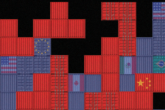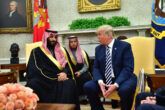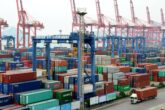May 05, 2020
Emerging Trends in Coercive Economic Measures Used by the United States and China
Results from a CNAS Poll
On April 24, the CNAS Energy, Economics, and Security (EES) program held a live discussion on trends in coercive economic measures in the U.S.-China relationship. This event coincided with the release of a new report, A New Arsenal for Competition: Coercive Economic Measures in the U.S.-China Relationship. CNAS report authors Elizabeth Rosenberg, Peter Harrell, and Ashley Feng offered comments on the topic, along with Damien Ma, Director of the Think Tank at The Paulson Institute.
U.S. and Chinese use of coercive economic measures, such as investment restrictions, export and trade controls, and sanctions, have become mainstream tools in U.S. and Chinese foreign policy to advance political and security objectives. Moreover, the use of these tools is now common in the U.S.-China economic competition, with both sides developing new tools and sharpening existing tools to achieve bilateral political and economic objectives. U.S. policymakers have reformed the Committee on the Foreign Investment in the United States and the export control system, while China has developed an unreliable entities list and begun implementing its corporate social credit system.
Looking forward, coercive economic measures appear likely to feature prominently in the U.S-China relationship in the years ahead. Roughly 200 participants in the CNAS event, including regional, security, and economic experts from governments, industry, and independent academic and research institutions, took a poll on how the use of coercive economic instruments in the U.S.-China relationship will shift in the years ahead. Several key themes emerged from the poll.
The U.S. and China appear likely to weaponize trade during the next year.
Almost 30 percent of poll respondents believed that the most likely tool that both the United States and China will use over the next twelve months in the bilateral economic competition will be bans on imports of specific goods and supply chain restrictions.
See below for the full results of the event participant poll:
Which of the following tools is likely to be the most used coercive economic tool in the U.S.-China relationship over the next twelve months?
| Bans on imports of specific products/supply chain restrictions | 28.0% |
| Export controls | 25.0% |
| Tariffs | 21.2% |
| Restrictions on investment (CFIUS; bans on foreign investment in specific sectors) | 18.9% |
| Other restrictions on foreign companies operating in-country (boycotts of specific companies; shutting down companies) | 5.3% |
| Sanctions | 4.5% |
| Other | 0% |
In the medium term, supply chain restrictions may be the key economic arena for U.S.-China competition.
In the medium term, participants believed that the weaponization of supply chains will also prevail as the most used measure of bilateral competition over the next five years. Specifically, 25 percent of respondents indicated their expectation that bans on imports of specific goods and supply chain restrictions will remain the most likely tool that both the United States and China will use. However, they also believe that investment restrictions will become a more important tool in the long term than export controls, with 23.5 percent of respondents saying that it will be the second most used tool in the U.S.-China relationship over the next five years.
See below for the full results of the event participant poll:
Which of the following tools is likely to be the most used coercive economic tool in the U.S.-China relationship over the next five years?
| Bans on imports of specific products/supply chain restrictions | 25.0% |
| Restrictions on investment (CFIUS; bans on foreign investment in specific sectors) | 23.5% |
| Export controls | 22.70% |
| Tariffs | 21.2% |
| Sanctions | 8.3% |
| Other restrictions on foreign companies operating in-country (boycotts of specific companies; shutting down companies) | 7.6% |
| Other | 1.5% |
China’s economic leverage may increase as a result of COVID-19.
The COVID-19 pandemic, which has shut down the world’s economies and factories, has also exacerbated pre-existing U.S-China economic tensions. As China’s economy reopens while the rest of the world remains shut down, many Western countries are concerned that a relatively stronger Chinese economy could increase Chinese economic leverage over foreign policies that the Chinese government doesn’t like. For example, China recently threated to cut off all Australian imports of wine and beef to China if Australian government didn’t stop pushing for an inquiry into how COVID-19 spread. Participants were similarly concerned, with 45.3 percent of respondents saying that Chinese economic leverage will only increase after COVID-19.
See below for the full results of the event participant poll:
Do you think that China's leverage will increase or decrease after COVID-19 has ended?
| Increase | 45.3% |
| Decrease | 32.1% |
| Stay the same | 22.6% |
Learn more:
A New Arsenal for Competition
Executive Summary The United States and China have long used coercive economic measures to advance both economic and foreign policy objectives. In recent years, however, both ...
Virtual Report Launch: Coercive Economic Measures in the U.S.-China Relationship
Peter Harrell, Damien Ma, Elizabeth Rosenberg, Ashley Feng
Apr 24, 2020
More from CNAS
-
Game Over?
The trade wargame suggests that sustained high tariffs could create leverage and urgency to spur action toward a productive restructuring of the international trade system....
By Emily Kilcrease & Geoffrey Gertz
-
Middle East Security / Energy, Economics & Security
Trump Inks $600 Bn Deal In Saudi Arabia | Musk, Blackrock CEO Flank Trump In Gulf VisitIn today's episode of India Global, U.S. President Donald Trump secured a $600 billion commitment from Saudi Arabia on Tuesday to invest in the United States. NDTV's Gaurie Dw...
By Daniel Silverberg
-
Energy, Economics & Security / Technology & National Security
Tariffs and Tech: An Uncertain RecipeHigher tariffs could prompt American cloud companies to shift more of their capital investments abroad....
By Pablo Chavez
-
Trump Tariffs: How Will U.S. Plans Reshape the Global Economy?
Donald Trump says he's already decided the tariffs he will impose on countries that export goods to America, including the United Kingdom. Channel 4 hears from Emily Kilcrease...
By Emily Kilcrease






